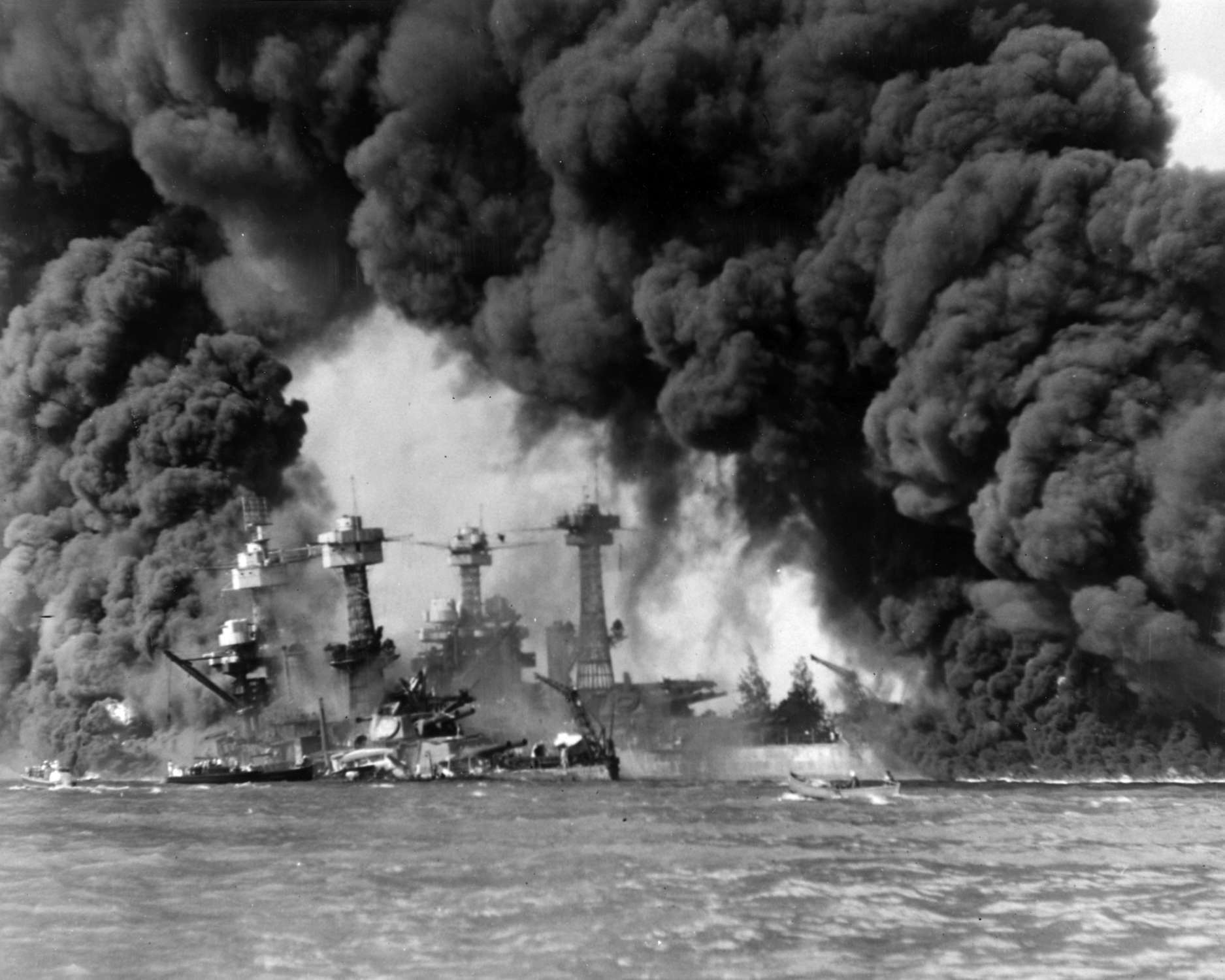
Burning ships at Pearl Harbor. National Archives and Records Administration, through Wikimedia. Click to enlarge.
By: Phil Kohn. Dedicated to the memory of his father, GM3 Walter Kohn, U.S. Navy Armed Guard, USNR, and all men and women who have answered the country’s call in time of need. Phil can be contacted at ww2remembered@yahoo.com.
Bitter cold weather, a lack of winter clothing, and equipment not designed to operate in such extreme temperatures brings the German attack on Moscow to a halt on December 5, 1941. Although the same frigid weather also affects the Soviets, they are better prepared for it and the Red Army counterattacks on a 500-mile front in blizzard conditions.
On December 6, Red Army offensives continue against German troops encircling Moscow. The Wehrmacht is subsequently pushed back some 200 miles. The United Kingdom declares war against Finland, Hungary and Romania, which have joined Germany in attacking the Soviet Union. From Washington, President Roosevelt sends a personal appeal for peace to Emperor Hirohito; he receives no reply. Also in D.C., a secret government committee meets to determine if an atomic bomb can be produced in the U.S., and at what cost.
At 7:53 a.m., Hawaiian Time, on Sunday, December 7, some 350 planes in two waves from six Imperial Japanese Navy aircraft carriers strike the U.S. Pacific Fleet at Pearl Harbor, Oahu, Hawaii. They also attack the U.S. Army Air Forces bases at Hickam, Wheeler and Bellows Fields on Oahu, as well as the naval air station at Kaneohe. In 90 minutes, 2,402 sailors, marines, soldiers and airmen are killed, 1,178 are wounded, 16 ships are sunk, including five battleships, and 347 aircraft are destroyed or damaged. Elsewhere in the Pacific, Japanese forces bombard Guam, Wake and Midway Islands. The Japanese declaration of war against the United States and Great Britain is published in Japanese evening newspapers, but the declaration is not formally delivered to the U.S. until the next day. (Japan also declares war on Australia, Canada, New Zealand and South Africa.) In North Africa, Rommel — realizing that he will not achieve success at Tobruk at this time — pulls his forces back some 10 miles westward toward Gazala, permitting relief of the British and Commonwealth garrison in the city. Canada and Panama declare war on Japan. In Berlin, Hitler issues the “Nacht und Nebel” (Night and Fog) decree, authorizing the SS, the Gestapo and the Wehrmacht to make political dissidents and resistance “helpers” vernebelt (meaning “transformed into mist” or vanish without a trace).
On December 8, one hour after President Roosevelt delivers a speech to a joint session of Congress that begins “Yesterday, December 7, 1941, a date that will live in infamy,” the U.S. declares war against Japan. In short order, the United Kingdom, Australia, New Zealand, the Netherlands, the Free French, Costa Rica, Cuba, El Salvador, Guatemala and Honduras also declare war on Japan. On the Eastern Front, “Operation Typhoon,” the German attack on Moscow, is suspended for the winter. Aviator Charles Lindbergh releases a statement through the America First Committee that says, in part: “ . . . [War] has come and we must meet it as united Americans . . . our country has been attacked by force of arms and we must retaliate.”
China officially declares war on Japan on December 9 even though the two countries have been fighting since July 1937. China also declares war on Germany and Italy. Japanese troops begin landing in Malaya, Thailand, Hong Kong and the Philippines. In the Pacific, the Japanese capture Makin and Tarawa, two of the Gilbert Islands. In Russia, the siege of Leningrad continues, with food supplies in the city starting to fall below starvation levels.
In the South China Sea north of Singapore on December 10, the British battleship HMS Prince of Wales and the battle cruiser HMS Repulse are attacked and sunk by 86 Japanese bombers and torpedo bombers based at Saigon. Among the 840 dead is Vice Admiral Sir Tom Phillips, who will be the highest-ranking Allied officer killed in battle during World War II. In the Mariana Islands, a Japanese force captures the 300-man garrison of U.S. sailors and Marines on Guam. In the Philippines, two large detachments of Japanese troops land on the north coast of the island of Luzon. In North Africa, German and Italian troops begin a full retreat westward from Tobruk.
Germany and Italy declare war on the United States on December 11; the U.S. responds in kind. The Japanese invade Burma, while in the Philippines a large Japanese force comes ashore at Legazpi, in southern Luzon. In the Pacific, U.S. troops repel an attempted Japanese landing on Wake Island, roughly halfway between Hawaii and the Philippines. Mildred Gillars — an American living in Germany who comes to be known as “Axis Sally” — delivers her first propaganda broadcast to Allied troops from studios in Berlin. In Chicago, the national directors of the America First Committee meet and vote to disband the organization.







